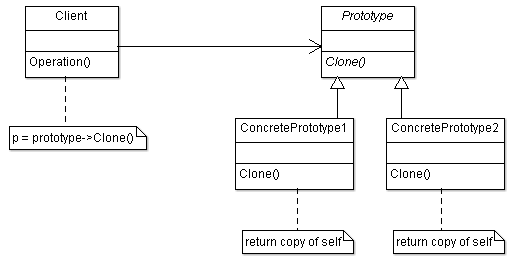> Design Patterns > Prototype Design Pattern
Prototype Design Pattern
Prototype design pattern is used to create an object by cloning a prototype.
Intent
- Specify the kinds of objects to create using a prototypical instance, and create new objects by copying this prototype.
So the intent of prototype design pattern is to create an object by using prototype.
Problem
- Framework needs to instantiate application specific objects.
That means we have a class in framework which wants to create application specific objects but does not know how to create and get those objects.
Solution
- Application can use the cloning of instance for subclasses.
We can have a prototype instance which is used to get abstract behavior of Prototype and clone the objects of subclasses.
Where Prototype Design Pattern is applicable?
- Framework to be used by developer
- To avoid parallel hierarchies.
- Wherever it is good to have a prototype and clone it, instead of creating a new object every time.
Prototype Design Pattern UML Structure

Participant classes of prototype design pattern
- Prototype class has abstract method Clone(). It provides interface for cloning the object.
- ConcretePrototype classes are derived from Prototype and implements the Clone() method. These classes clone their respective object and returns it to client.
- Client has the prototype instance and uses its interface for cloning.
How they work together?
- Client has instance of Prototype. It uses the Clone() method of Prototype to clone itself.
- It is hiding internal information of product. We can have products added or removed at run time by having prototype instance whenever required. Reduces subclasses by avoiding parallel hierarchies. You can have prototype instance as part of another object.
- It requires Clone() method in every prototype class. It may be difficult to add in existing classes. Also sometime it will be difficult when object does not support copy and has circular reference.
- We can have Prototype Manager which will manage all the prototypes that includes registering and removing. Client can just use Prototype Manager with well-defined access.
- Cloning has to be taken care appropriately like in case of circular reference. We should be able to make difference for the use of shallow or deep copy for different scenario. Also there may be requirement for having state of objects which may require separate method for initialization.
- Prototype is very useful pattern and generally used with other patterns too.
Prototype Design Pattern Example
Here is the prototype factory design pattern example.
There are many different systems like IBM, HP, Unisys, DELL, MAC etc. A system management framework has interface Clone to have a clone of objects of these systems which are provided by user.
Implementation Code
| C++ | Prototype Pattern in C++ | Prototype Pattern C++ Example |
| C# | Prototype Pattern in C# | Prototype Pattern C# Example |
| Java | Prototype Pattern in Java | Prototype Pattern Java Example |
| Python | Prototype Pattern in Python | Prototype Pattern Python Example |
| JavaScript | Prototype Pattern in JavaScript | Prototype Pattern JavaScript Example |
| PHP | Prototype Pattern in PHP | Prototype Pattern PHP Example |
| Ruby | Prototype Pattern in Ruby | Prototype Pattern Ruby Example |
| Swift | Prototype Pattern in Swift | Prototype Pattern Swift Example |
| Objective-C | Prototype Pattern in Objective-C | Prototype Pattern Objective-C Example |
Suresh Kumar Srivastava is founder of online learning site coursegalaxy.com and author of popular books C In Depth, Data Structures Through C In Depth. He has 18+ years experience in industry and worked on architecture and design of multiple products. This article Prototype Design Pattern is from his Design Patterns course.

